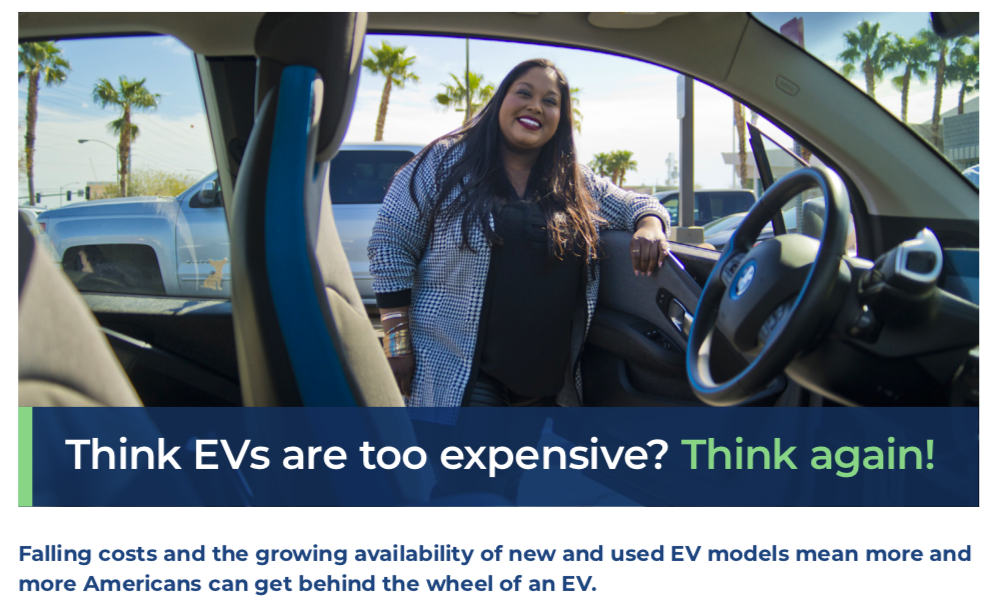Falling costs and the growing availability of new and used EV models mean more and more Americans can get behind the wheel of an EV.
There are 1.5 million electric vehicles on the road in the U.S. today. The majority of these cars were acquired on two- and three-year leases, which means hundreds of thousands of EVs are either already available on the used car market or soon will be. The nearly-new EVs coming off leases typically have 60,000-70,000 miles remaining on their warranties and many can be acquired for less than $13,000.
And just in time: More Americans from all walks of life are interested in purchasing electric vehicles than ever before. According to a 2019 survey by Consumer Reports and the Union of Concerned Scientists, 63 percent of prospective car buyers are interested in or planning on purchasing an EV for their next car, including 31 percent of people making less than $50k a year.
EV AFFORDABILITY FACTS
Prices of EVs are dropping
EVs are expected to be cost-competitive with combustion-engine cars by the mid-2020s without the assistance of state or federal purchase incentives. Today, you can already get into a new EV for less than the median price of a new conventional car.
Prices for EVs continue to drop year after year, even during the pandemic. From Sept. 2019 to Sept. 2020, the median sales price for a new EV dropped 2 percent, while the average price for new conventional vehicles rose 2.5 percent, according to Kelley Blue Book.
Several model 2020 EVs are listed below the median sales price ($38,723) for a new gas-powered car, such as the 2020 Nissan Leaf (MSRP $31,600), 2020 Hyundai Ioniq Electric (MSRP $33,045) and 2020 Chevy Bolt (MSRP $36,620). Even the 2020 Tesla Model 3 can compete with an MSRP of $35,400.
When you add in the federal tax rebate of up to $7,500 and state incentives, the cost of purchasing a new EV is even more affordable.
Despite the pandemic, automakers are accelerating their EV launch plans and by 2022, there will be over 500 different EV models available globally.
The used EV market is booming
The vast majority of U.S. car buyers purchase used vehicles, not new ones. Used EVs are more economical than used conventional cars, especially considering most are newer models and they are cheaper to fuel and maintain.
Nearly 80 percent of most models of EVs are leased. That means there’s a growing number of
nearly-new used EVs with low miles and in good condition headed back to dealerships.
Deals on used EVs abound. According to Kelley Blue Book, a base model 2017 Nissan Leaf or Ford Focus in good condition sells for between $10k-$13K, or you could get your hands on a 2017 BMW i3 for $17K to $21K.
EV owners love their cars. In a recent survey of 40,000 EV drivers, 96 percent said they would buy an EV again, and 87 percent said their EV was their first choice for transportation in their household, even if they also owned a gas powered car.
EVs cost less to own than gas powered cars
New or used – EVs cost thousands of dollars less to own and operate than gas-powered cars over their lifetimes.
According to a recent Consumer Reports analysis, EV owners pay 50 percent less on repair and maintenance costs and 60 percent less on fuel than owners of gas-powered vehicles.
After you account for fuel cost savings, a consumer who leases a new EV or finances a used EV could
spend about $100 a month, comparable to what many spend on a cell phone or cable/internet bill.
In Nevada, driving on electricity is the cost-equivalent of driving on $0.98/gallon gasoline. And on the right utility plan, it would cost as little as $0.41/gallon.
When you add it all up, owning an EV will save the typical driver $6,000 to $10,000 over the life of the vehicle, compared to a comparable gas-powered car.
To ensure more Americans can get behind the wheel of an EV we must:
Continue and expand tax credits and incentives for purchasing EVs
Focus incentives for those who need them the most
Stop states from imposing excessive fees and taxes on EVs
Increase investment in clean mobility options such as busses, vanpools and ride-sharing services
Increase access to charging stations so consumers can realize the fuel cost savings EVs can provide

